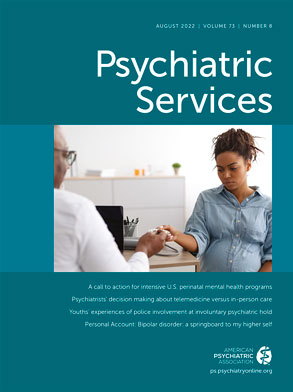A Systematic Review of Interventions Targeting Criminogenic Risk Factors Among Persons With Serious Mental Illness
Abstract
Objective:
Methods:
Results:
Conclusions:
HIGHLIGHTS
Methods
Eligibility Criteria
Search Strategy
Data Extraction
Quality Assessment
Results
Methodological Characteristics
Samples.
Quality.
| Study | Alla | RCTb | Nonrandomc | Descriptived | Qualitativee | |||||||||||||||||
|---|---|---|---|---|---|---|---|---|---|---|---|---|---|---|---|---|---|---|---|---|---|---|
| 1 | 2 | 1 | 2 | 3 | 4 | 5 | 1 | 2 | 3 | 4 | 5 | 1 | 2 | 3 | 4 | 5 | 1 | 2 | 3 | 4 | 5 | |
| Ashford et al., 2008 (32) | ✓ | ✓ | ✓ | ✓ | ||||||||||||||||||
| Carr and Cassidy, 2016 (36) | ✓ | ✓ | ✓ | ✓ | ✓ | ✓ | ||||||||||||||||
| Clarke et al., 2010 (48) | ✓ | ✓ | ✓ | ✓ | ✓ | ✓ | ||||||||||||||||
| Cullen et al., 2011 (35) | ✓ | ✓ | ✓ | ✓ | ✓ | ✓ | ||||||||||||||||
| Cullen et al., 2012 (34) | ✓ | ✓ | ✓ | ✓ | ✓ | ✓ | ||||||||||||||||
| Cullen et al., 2012 (33) | ✓ | ✓ | ✓ | ✓ | ✓ | ✓ | ||||||||||||||||
| C-Y Yip et al., 2013 (37) | ✓ | ✓ | ✓ | ✓ | ✓ | |||||||||||||||||
| Erickson et al., 2009 (38) | ✓ | ✓ | ✓ | ✓ | ||||||||||||||||||
| Jotangia et al., 2015 (43) | ✓ | ✓ | ✓ | ✓ | ✓ | ✓ | ||||||||||||||||
| Howden et al., 2018 (40) | ✓ | ✓ | ✓ | ✓ | ✓ | |||||||||||||||||
| Lamberti et al., 2017 (28) | ✓ | ✓ | ✓ | ✓ | ✓ | ✓ | ||||||||||||||||
| McKendrick et al., 2006 (42) | ✓ | ✓ | ✓ | ✓ | ||||||||||||||||||
| Rees-Jones et al., 2012 (45) | ✓ | ✓ | ✓ | ✓ | ✓ | ✓ | ||||||||||||||||
| Sacks et al., 2004 (41) | ✓ | ✓ | ✓ | ✓ | ||||||||||||||||||
| Sullivan et al., 2007 (49) | ✓ | ✓ | ✓ | ✓ | ||||||||||||||||||
| Sullivan et al., 2007 (50) | ✓ | ✓ | ✓ | ✓ | ||||||||||||||||||
| Wilson et al., 2018 (27) | ✓ | ✓ | ✓ | ✓ | ✓ | |||||||||||||||||
| Yates et al., 2005 (46) | ✓ | ✓ | ✓ | ✓ | ✓ | |||||||||||||||||
| Yates et al., 2010 (47) | ✓ | ✓ | ✓ | ✓ | ✓ | ✓ | ||||||||||||||||
| Young et al., 2016 (44) | ✓ | ✓ | ✓ | ✓ | ✓ | ✓ | ||||||||||||||||
Intervention Characteristics
| Intervention | Description | Clinical orientation | Treatment targets | Setting | Structure | Length and duration |
|---|---|---|---|---|---|---|
| Reasoning and Rehabilitation (R&R) | Manualized cognitive-behavioral intervention developed for antisocial adolescents and adults evidencing antisocial behaviors or criminal behavior | Cognitive behavioral | Problem solving, criminal thinking, antisocial behavior | Forensic hospitals | Weekly group and individual sessions delivered by trained facilitators | 36 structured, 90-minute sessions |
| Reasoning and Rehabilitation Mental Health Program (R&R2MHP) | A revised version of R&R developed for antisocial adolescents and adults evidencing antisocial behaviors or criminal behavior who have mental health problems | Cognitive behavioral | Self-control, problem solving, emotional control, social skills, critical reasoning | Forensic hospitals | Weekly group and individual sessions delivered by trained facilitators. Each participant meets weekly with a peer mentor to assist with skill building. | 16 structured, 90-minute sessions |
| Forensic assertive community treatment programs (FACT) | A team-based service delivery model for justice-involved individuals with serious mental illness. Builds on the assertive community treatment model by addressing criminal justice issues | Cognitive behavioral | Modifiable risk factors for criminal recidivism | Outpatient community treatment centers | Clinical and case management services are delivered by a multidisciplinary team that maintains a partnership with a criminal justice agency to perform jail diversion. | Services delivered as needed 24/7 |
| System for Treatment and Abatement of Interpersonal Risk program (STAIR) | Inpatient program developed for justice-involved persons with mental health problems | Cognitive behavioral | Problem solving, creative thinking, values enhancement, social skills, critical reasoning, managing emotions | Psychiatric hospitals | Weekly group therapy sessions are delivered by trained social workers or psychologists. Incorporates a contingency management component consisting of seven steps designed to reward participants for their treatment progress. All participants are provided with psychopharmacological management. | 72 45-minute sessions delivered twice a week for 6 months or more |
| Modified therapeutic community (MTC) | A residential, modified therapeutic community cognitive-behavioral treatment program designed for delivery in institutional settings | Cognitive behavioral | Substance abuse, mental illness, criminal thinking, criminal behavior | Community | Psychoeducational classes, cognitive-behavioral protocols, medication, and therapeutic interventions. Services include a peer-based component. | 4–5 hours per day, 5 days a week for 12 months |
| Monterey County Supervised Treatment After Release (MCSTAR) | Comprehensive postplea diversion programs designed to target criminal behavior; included a constituent program, Creating New Choices | Cognitive behavioral | Criminal thinking, hostile attributions | Community | A mental health court intervention, psychiatric treatment, supervision and support through a FACT team, and special housing resources. Also includes a cognitive intervention based on the Options program and modified by the Maricopa County Adult Probation Department. This intervention targets antisocial attitudes, problem solving, and decision-making skills. | 36 2-hour sessions typically offered two to five times a week for about 8 weeks. This time frame was modified to be delivered over 4–6 months. |
| Community Reporting Engagement Support and Training (CREST) | Enhanced, cognitive-behavioral day-reporting program delivered in collaboration with a local community mental health clinic | Cognitive behavioral | Relapse prevention, health and wellness, life skills | Enhanced day-reporting center | Psychiatric assessment and treatment services, case management, and psychosocial program that uses a cognitive-behavioral approach. Manual-based, cognitive-behavioral, and psychoeducational groups are offered, and the program is delivered in part by peer specialists. | Schedule varies depending on need. Program length and completion are determined by day-reporting center staff. |
| Targeted service delivery approach (TSDA) | A set of five service delivery strategies designed to be used with cognitive-behavioral interventions targeting criminal risk factors to increase their responsivity to the needs of justice-involved persons with serious mental illness | Cognitive behavioral | Criminogenic risk factors | Prison | The TSDA was used to adapt the delivery of interventions targeting criminogenic risks to meet the needs of persons with mental illness. Interventions using the TSDA are delivered by two trained facilitators weekly. | Underlying cognitive-behavioral intervention delivered over two 60- to 90-minute sessions twice per week for 12–14 weeks |
| Violent Offender Treatment Program (VOTP) | A cognitive-behavioral program developed for men with mental disorders in forensic hospitals who have habitual aggression and high risk for violent recidivism | Cognitive behavioral | Symptom-related violence, violence displayed as a result of symptomatology, and violence independent of symptomatology | Medium secure unit in a psychiatric hospital | 9 manualized treatment modules delivered in four phases and delivered in twice-weekly, 2-hour sessions. Participants also receive support from mentors in between sessions. | 84 hours of treatment facilitated over a 7-month period |
Substantive Findings
Antisocial personality pattern.
Antisocial cognitions.
Substance abuse.
Recidivism.
Violence.
Mental health.
Treatment completion.
Discussion
Methodological Characteristics
Intervention Characteristics
Substantive Findings
Limitations
Conclusions
Footnote
Supplementary Material
- View/Download
- 318.26 KB
References
Information & Authors
Information
Published In
History
Keywords
Authors
Funding Information
Metrics & Citations
Metrics
Citations
Export Citations
If you have the appropriate software installed, you can download article citation data to the citation manager of your choice. Simply select your manager software from the list below and click Download.
For more information or tips please see 'Downloading to a citation manager' in the Help menu.
View Options
View options
PDF/EPUB
View PDF/EPUBLogin options
Already a subscriber? Access your subscription through your login credentials or your institution for full access to this article.
Personal login Institutional Login Open Athens loginNot a subscriber?
PsychiatryOnline subscription options offer access to the DSM-5-TR® library, books, journals, CME, and patient resources. This all-in-one virtual library provides psychiatrists and mental health professionals with key resources for diagnosis, treatment, research, and professional development.
Need more help? PsychiatryOnline Customer Service may be reached by emailing [email protected] or by calling 800-368-5777 (in the U.S.) or 703-907-7322 (outside the U.S.).

